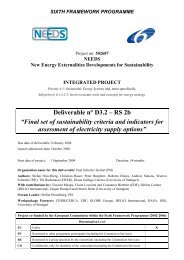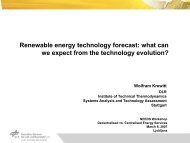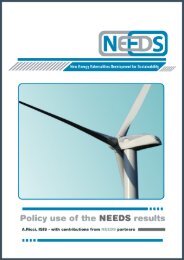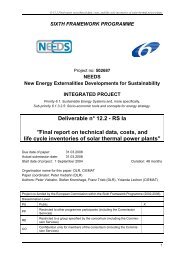Generation, of the energy carrier HYDROGEN In context ... - needs
Generation, of the energy carrier HYDROGEN In context ... - needs
Generation, of the energy carrier HYDROGEN In context ... - needs
Create successful ePaper yourself
Turn your PDF publications into a flip-book with our unique Google optimized e-Paper software.
NyOrka Page 19 12/18/20084 Electrolysis technology development pathwaysThe drivers for using hydrogen as <strong>energy</strong> <strong>carrier</strong> or buffer for grids are:• Distributed production i.e. near <strong>the</strong> customer• Diversification <strong>of</strong> <strong>energy</strong> sources and availability <strong>of</strong> water supply• Clean operation, - important in cities to lower sooth• Good integration possibilities with established electric systems and modules• Buffering opportunities to meet fluctuations between production and demand withrenewable <strong>energy</strong> systems• Stand alone applications in remote areas possible• Benign environmental effects during use phase• High <strong>energy</strong> quality characteristics• Combined heat and power production with use <strong>of</strong> certain Fuel Cells• Easy integration with upcoming transport schemesDuring <strong>the</strong> first stages <strong>of</strong> introduction, hydrogen from industry and central gas reformingis seen as <strong>the</strong> main source. Hydrogen will be foremost used as fuel for transport wi<strong>the</strong>lectric vehicles, and in figure 8 Hydrogen is placed as fuel at <strong>the</strong> future end fordecarbonised fuel types, but hydrogen technology has been used in viable <strong>energy</strong> systemsfor decades Two main pathways are predicted for electrolysis when demand rises in <strong>the</strong>second and third decade <strong>of</strong> <strong>the</strong> 21 st century; Electrolysis using PEM electrolysers on onehand and high heat, high pressure lye electrolysis on <strong>the</strong> o<strong>the</strong>r. The PEM technology isforeseen as a small module for specific applications while bulk production may requirelye electrolysis, which is proven technology. High heat and pressure electrolysis shouldoccur at temperatures near500°C (supercritical heat) ormore and is foreseen in <strong>context</strong>with solar <strong>the</strong>rmal towertechnologies, high geo<strong>the</strong>rmalheat and nuclear power coolingfacilities.Figure 8 Energy road-maps for <strong>the</strong>new century predict that fuel typesfor transport, will containgradually less carbon. 14 .Due to purity demands, <strong>the</strong>selected hydrogen deploymenttechnology will influencewhich production pathway isused. The PEM fuel celldemands high purity while o<strong>the</strong>r types <strong>of</strong> fuel cells can use hydrogen mixed with o<strong>the</strong>rgaseous fuel. The PEM is promoted in <strong>context</strong> with transport drive trains as <strong>the</strong>y arecompact and operate at temperatures below 100°C. Recent developments have shown14 Minns David (editor) 2005, APEC 2030 <strong>In</strong>tegrated Fuel technology roadmap







